Renewable Energy Sources in a Post-Socialist Transitional Environment: The Influence of Social Geographic Factors on Potential Utilization of Very Shallow Geothermal Energy within Heating Systems in Small Serbian Town of Ub
Abstract
:1. Introduction
2. Energetic Stability and Renewable Energy Sources
3. Geothermal Energy and How Is It Used
4. District Heating Systems
5. Heating Systems and Renewable Energy Solutions in Serbia
“With higher number of heating consumers and a small object density, i.e., large number of apartments per object, district heating system is a better solution”.[57] (p. 151)
“New energy use patterns and technologies need to be adopted if the economy is to grow and poverty is to be reduced”.[69] (p. 5)
6. Ub—Social Geographic and Energetic Overview
7. Very Shallow Geothermal Potentials of Ub
8. Discussion
8.1. Technical Limitations
8.2. Economic Limitations
8.3. Social and Political Limitations
9. Conclusions
Author Contributions
Funding
Conflicts of Interest
References
- Agencija za Zaštitu Životne Sredine. Kvalitet Vazduha u Republici Srbiji 2018. Godine; Ministarstvo Zaštite Životne Sredine: Belgrade, Serbia, 2019. Available online: http://www.sepa.gov.rs/download/izv/Vazduh2018_final.pdf (accessed on 12 November 2019).
- Winkler, A. Measuring Regional Inequality: An Index of Socio-Economic Pressure for Serbia. Collect. Pap. Fac. Geogr. Univ. Belgrade 2012, 60, 81–102. [Google Scholar]
- Bertermann, D.; Klug, H.; Morper-Busch, L. A pan-European planning basis for estimating the very shallow geothermal energy potentials. Renew. Energy 2015, 75, 335–347. [Google Scholar] [CrossRef]
- Jess, A.; Kaiser, P.; Kern, C.; Unde, R.B.; von Olshausen, C. Considerations concerning the Energy Demand and Energy Mix for Global Welfare and Stable Ecosystems. Chem. Ing. Tech. 2011, 83, 1777–1791. [Google Scholar] [CrossRef]
- Fulkerson, W.; Judkins, R.R.; Sanghvi, M.K. Energy from Fossil Fuels. Sci. Am. 1990, 263, 128–135. [Google Scholar] [CrossRef]
- Ellabban, O.; Abu-Rub, H.; Blaabjerg, F. Renewable energy resources: Current status, future prospects and their enabling technology. Renew. Sustain. Energy Rev. 2014, 39, 748–764. [Google Scholar] [CrossRef]
- Guerrero, D.G. The Limits of Capitalist Solutions to the Climate Crisis. In The Climate Crisis: South African and Global Democratic Eco-Socialist Alternatives; Satgar, V., Ed.; Wits University Press: Johannesburg, South Africa, 2018; pp. 30–46. [Google Scholar] [CrossRef]
- Panwar, N.L.; Kaushik, S.C.; Kothari, S. Role of renewable energy sources in environmental protection: A review. Renew. Sustain. Energy Rev. 2011, 15, 1513–1524. [Google Scholar] [CrossRef]
- Dincer, I. Renewable energy and sustainable development: A crucial review. Renew. Sustain. Energy Rev. 2000, 4, 157–175. [Google Scholar] [CrossRef]
- Fridleifsson, I.B. Status of geothermal energy amongst the world’s energy sources. Geothermics 2003, 32, 379–388. [Google Scholar] [CrossRef]
- Starr, C.; Searl, M.F.; Alpert, S. Energy Sources: A Realistic Outlook. Science 1992, 256, 981–987. [Google Scholar] [CrossRef]
- Carter, L.J. Nuclear Imperatives and Public Trust: Dealing with Radioactive Waste, 1st ed.; Resources for the Future: Washington, DC, USA, 1987. [Google Scholar]
- Saling, J.H.; Fentiman, A.W. Radioactive Waste Management, 2nd ed.; Taylor & Francis: New York, NY, USA, 2001. [Google Scholar]
- Goldemberg, J. The promise of clean energy. Energy Policy 2006, 34, 2185–2190. [Google Scholar] [CrossRef]
- REN21. Renewables 2019 Global Status Report; REN21 Secretariat: Paris, France, 2019. [Google Scholar]
- Johansson, T.B.; Kelly, H.; Reddy, A.; Williams, R.; Burnham, L. Renewable Energy: Sources for Fuels and Electricity; Island Press: Washington, DC, USA, 1993. [Google Scholar]
- Boyle, G. Renewable Energy, 2nd ed.; Oxford University Press in Association with the Open University: Oxford, UK; New York, NY, USA, 2004. [Google Scholar]
- Romm, J. One Fact about Climate Change That’s Worth Repeating. Available online: https://thinkprogress.org/one-fact-about-climate-change-thats-worth-repeating-39ffa04bdf0e/ (accessed on 11 November 2019).
- Haas, R.; Resch, G.; Panzer, C.; Busch, S.; Ragwitz, M.; Held, A. Efficiency and effectiveness of promotion systems for electricity generation from renewable energy sources—Lessons from EU countries. Energy 2011, 36, 2186–2193. [Google Scholar] [CrossRef]
- Ahmad, S.; Tahar, R.M. Selection of renewable energy sources for sustainable development of electricity generation system using analytic hierarchy process: A case of Malaysia. Renew. Energy 2014, 63, 458–466. [Google Scholar] [CrossRef]
- Kaldellis, J.K.; Zafirakis, D. Optimum energy storage techniques for the improvement of renewable energy sources-based electricity generation economic efficiency. Energy 2007, 32, 2295–2305. [Google Scholar] [CrossRef]
- Denholm, P.; Ela, E.; Kirby, B.; Milligan, M. Role of Energy Storage with Renewable Electricity Generation; National Renewable Energy Laboratory: Golden, CO, USA, 2010. [Google Scholar] [CrossRef] [Green Version]
- Sen, R.; Bhattacharyya, S.C. Off-grid electricity generation with renewable energy technologies in India: An application of HOMER. Renew. Energy 2014, 62, 388–398. [Google Scholar] [CrossRef]
- Mathiesen, B.V.; Lund, H.; Connolly, D.; Wenzel, H.; Østergaard, P.A.; Möller, B.; Nielsen, S.; Ridjan, I.; Karnøe, P.; Sperling, K.; et al. Smart Energy Systems for coherent 100% renewable energy and transport solutions. Appl. Energy 2015, 145, 139–154. [Google Scholar] [CrossRef]
- Cansino, J.M.; del Pablo-Romero, M.P.; Román, R.; Yñiguez, R. Promoting renewable energy sources for heating and cooling in EU-27 countries. Energy Policy 2011, 39, 3803–3812. [Google Scholar] [CrossRef]
- Barbier, E. Geothermal energy technology and current status: An overview. Renew. Sustain. Energy Rev. 2002, 6, 3–65. [Google Scholar] [CrossRef]
- Dickson, M.H.; Fanelli, M. Geothermal Energy: Utilization and Technology; Earthscan: Sterling, VA, USA, 2005. [Google Scholar]
- Bloomquist, R.G. Geothermal space heating. Geothermics 2003, 32, 513–526. [Google Scholar] [CrossRef] [Green Version]
- Adaro, J.A.; Galimberti, P.D.; Lema, A.I.; Fasulo, A.; Barral, J.R. Geothermal contribution to greenhouse heating. Appl. Energy 1999, 64, 241–249. [Google Scholar] [CrossRef]
- Bakos, G.C.; Fidanidis, D.; Tsagas, N.F. Greenhouse heating using geothermal energy. Geothermics 1999, 28, 759–765. [Google Scholar] [CrossRef]
- Lund, J.W.; Freeston, D.H. World-wide direct uses of geothermal energy 2000. Geothermics 2001, 30, 29–68. [Google Scholar] [CrossRef] [Green Version]
- Stober, I.; Bucher, K. Geothermie; Springer: Berlin/Heidelberg, Germany, 2014. [Google Scholar]
- Antics, M.; Sanner, B. Status of Geothermal Energy Use and Resources in Europe. In Proceedings of the European Geothermal Congress, Unterhaching, Germany, 30 May–1 June 2007. [Google Scholar]
- Hähnlein, S.; Bayer, P.; Blum, P. International legal status of the use of shallow geothermal energy. Renew. Sustain. Energy Rev. 2010, 14, 2611–2625. [Google Scholar] [CrossRef]
- Hähnlein, S.; Bayer, P.; Ferguson, G.; Blum, P. Sustainability and policy for the thermal use of shallow geothermal energy. Energy Policy 2013, 59, 914–925. [Google Scholar] [CrossRef]
- Bertermann, D.; Klug, H.; Morper-Busch, L.; Bialas, C. Modelling vSGPs (very shallow geothermal potentials) in selected CSAs (case study areas). Energy 2014, 71, 226–244. [Google Scholar] [CrossRef]
- Bertermann, D.; Müller, J.; Freitag, S.; Schwarz, H. Comparison between Measured and Calculated Thermal Conductivities within Different Grain Size Classes and Their Related Depth Ranges. Soil Syst. 2018, 2, 50. [Google Scholar] [CrossRef] [Green Version]
- Lund, J.W.; Freeston, D.H.; Boyd, T.L. Direct utilization of geothermal energy 2010 worldwide review. Geothermics 2011, 40, 159–180. [Google Scholar] [CrossRef]
- Sanner, B. Summary of EGC 2019 Country Update Reportson Geothermal Energy in Europe. In Proceedings of the European Geothermal Congress, Den Haag, The Netherlands, 11–14 June 2019. [Google Scholar]
- Self, S.J.; Reddy, B.V.; Rosen, M.A. Geothermal heat pump systems: Status review and comparison with other heating options. Appl. Energy 2013, 101, 341–348. [Google Scholar] [CrossRef]
- Köfinger, M.; Basciotti, D.; Schmidt, R.R.; Meissner, E.; Doczekal, C.; Giovannini, A. Low temperature district heating in Austria: Energetic, ecologic and economic comparison of four case studies. Energy 2016, 110, 95–104. [Google Scholar] [CrossRef]
- Hepbasli, A. A review on energetic, exergetic and exergoeconomic aspects of geothermal district heating systems (GDHSs). Energy Convers. Manag. 2010, 51, 2041–2061. [Google Scholar] [CrossRef]
- Yoon, T.; Ma, Y.; Rhodes, C. Individual Heating systems vs. District Heating systems: What will consumers pay for convenience? Energy Policy 2015, 86, 73–81. [Google Scholar] [CrossRef]
- Münster, M.; Morthorst, P.E.; Larsen, H.V.; Bregnbæk, L.; Werling, J.; Lindboe, H.H.; Ravn, H. The role of district heating in the future Danish energy system. Energy 2012, 48, 47–55. [Google Scholar] [CrossRef] [Green Version]
- Lake, A.; Rezaie, B.; Beyerlein, S. Review of district heating and cooling systems for a sustainable future. Renew. Sustain. Energy Rev. 2017, 67, 417–425. [Google Scholar] [CrossRef]
- Lund, H.; Werner, S.; Wiltshire, R.; Svendsen, S.; Thorsen, J.E.; Hvelplund, F.; Mathiesen, B.V. 4th Generation District Heating (4GDH). Energy 2014, 68, 1–11. [Google Scholar] [CrossRef]
- Lund, H.; Østergaard, P.A.; Chang, M.; Werner, S.; Svendsen, S.; Sorknæs, P.; Thorsen, J.E.; Hvelplund, F.; Mortensen, B.O.G.; Mathiesen, B.V.; et al. The status of 4th generation district heating: Research and results. Energy 2018, 164, 147–159. [Google Scholar] [CrossRef]
- Torchio, M.F.; Genon, G.; Poggio, A.; Poggio, M. Merging of energy and environmental analyses for district heating systems. Energy 2009, 34, 220–227. [Google Scholar] [CrossRef]
- Werner, S. International review of district heating and cooling. Energy 2017, 137, 617–631. [Google Scholar] [CrossRef]
- Connolly, D.; Lund, H.; Mathiesen, B.V.; Werner, S.; Möller, B.; Persson, U.; Boermans, T.; Trier, D.; Østergaard, P.A.; Nielsen, S. Heat Roadmap Europe: Combining district heating with heat savings to decarbonise the EU energy system. Energy Policy 2014, 65, 475–489. [Google Scholar] [CrossRef]
- Thorsteinsson, H.H.; Tester, J.W. Barriers and enablers to geothermal district heating system development in the United States. Energy Policy 2010, 38, 803–813. [Google Scholar] [CrossRef]
- Mrkić Bosančić, M.; Gvero, P.; Ibrulj, J.; Husika, A.; Vasković, S. Komparacija sistema daljinskog grijanja gradova zemalja u tranziciji. Mašinstvo 2017, 4, 193–202. [Google Scholar]
- Winkler, A. Räumliche Differenzierung und Lokale Entwicklung: Divergente Transformationspfade am Beispiel Serbischer Kommunen; University of Bamberg Press: Bamberg, Germany, 2015; ISBN 978-3-86309-318-1. [Google Scholar]
- Jocić, N. Creative Economy in a Post-Socialist Transitional Context: Spatial Distribution of Creative Activities and Their Interrelation with Urban Milieus in City Quarters of Belgrade; University of Bamberg Press: Bamberg, Germany, 2019. [Google Scholar]
- Đurić, S.; Krstić, M.; Jović, K. Serbien und Montenegro. Energieeffizienz in Gebäuden. Zielmarktanalyse 2019 mit Profilen der Marktakteure; Deutsch-Serbische Wirtschaftskammer (AHK Serbien): Belgrade, Serbia, 2019. [Google Scholar]
- Lund, H.; Hvelplund, F.; Kass, I.; Dukalskis, E.; Blumberga, D. District heating and market economy in Latvia. Energy 1999, 24, 549–559. [Google Scholar] [CrossRef]
- Brkić, D. Natural gas heating in Serbian settlements according to urbanity parameters. Facta Univ. Ser. Archit. Civ. Eng. 2008, 6, 139–153. [Google Scholar] [CrossRef]
- Jorgenson, A.K.; Longhofer, W.; Grant, D.; Sie, A.; Giedraitis, V. The effects of economic and political integration on power plants’ carbon emissions in the post-soviet transition nations. Environ. Res. Lett. 2017, 12, 044009. [Google Scholar] [CrossRef] [Green Version]
- Mutani, G.; Vicentini, G. Buildings’ energy consumption, energy savings potential and the availability of renewable energy sources in urban spaces. J. Civ. Eng. Archit. Res. 2015, 2, 1102–1115. [Google Scholar]
- Grković, V. Optimizations for district heating of Belgrade from the Kolubara energy and industrial complex. Energy 1989, 14, 747–756. [Google Scholar] [CrossRef]
- Dondur, N.; Cvetković, M. Economic appraisal of environmental effects: District heating project case study in Former Yugoslavia. Proj. Apprais. 1997, 12, 119–125. [Google Scholar] [CrossRef]
- Vasiljević, P.; Savić, R. Rehabilitation of District Heating in Serbia. Available online: https://www.lsta.lt/files/seminarai/080911_Budapestas/Serbia1.pdf (accessed on 13 November 2019).
- Osmanoski, T.; Valdevit, D.; Karličić, N. Gašenje individualnih kotlovskih postrojenja i povezivanje na toplovodnu mrežu sistema daljinskog grejanja. Zb. Međunarodnog Kongr. Procesnoj Ind. Procesing 2017, 30, 311–322. [Google Scholar] [CrossRef] [Green Version]
- United Nations Development Programme (UNDP). Fossil Fuel Subsidiesin the Western Balkans; UNDP Regional Bureau for Europe and the Commonwealth of Independent States (RBEC): New York, NY, USA, 2011. [Google Scholar]
- Republički Zavod za Statistiku Srbije. Stanovi Prema Vrsti Energenata za Grejanje: Podaci po Opštinama i Gradovima = Dwellings by the Type of Raw Material Used for Heating: Data by Municipalities/Cities; Republički Zavod za Statistiku Srbije: Belgrade, Serbia, 2013. Available online: https://publikacije.stat.gov.rs/G2013/Pdf/G20134023.pdf (accessed on 11 November 2019).
- Stevanović, V.; Banjac, M. Energetska efikasnost daljinskog grejanja u Srbiji. Zb. Međunarodnog Kongr. KGH 2017, 46, 64–69. [Google Scholar]
- Mariottini, F.; Georgiev, Z. The Challenges, Dynamics and Activities in the Building Sector and Its Energy Demand in the Republic of Serbia. D2.1 of WP2 from Entranze Project. 2013. Available online: https://www.researchgate.net/publication/314151872_The_Challenges_Dynamics_and_Activities_in_the_Building_Sector_and_its_Energy_Demand_in_Serbia_ENTRANZE_D21_of_WP2_from_Entranze_Project (accessed on 13 November 2019).
- Brkić, D. Energy Situation in the Republic of Serbia. Preprints 2018, 2018080279. Available online: https://doi.org/10.20944/preprints201808.0279.v1 (accessed on 14 November 2019).
- United Nations Development Programme (UNDP). Stuck in the Past—Energy, Environment and Poverty in Serbia and Montenegro; United Nations Development Programme: Belgrade, Serbia, 2004. [Google Scholar]
- Rehm Bogunović, D. Introduction: Still Stuck in the Past. Energy and Climate Change in South East Europe. Perspect. Polit. Anal. Comment. 2018, 3–4. Available online: https://rs.boell.org/sites/default/files/perspectives_srb_2018.pdf (accessed on 13 November 2019).
- Germany Trade & Invest. Serbiens Gebäude verbrauchen zu viel Energie. Available online: https://www.gtai.de/GTAI/Navigation/DE/Trade/Maerkte/suche,t=serbiens-gebaeude-verbrauchen-zu-viel-energie,did=2294950.html (accessed on 2 December 2019).
- Stevanović, S.; Pucar, M. Financial measures Serbia should offer for solar water heating systems. Energy Build. 2012, 54, 519–526. [Google Scholar] [CrossRef]
- Radivojević, A.; Pavlović, T.; Milosavljević, D.; Đorđević, A.; Pavlović, M.; Filipović, I.; Pantić, L.; Punišić, M. Influence of climate and air pollution on solar energy development in Serbia. Therm. Sci. 2015, 19, 311–322. [Google Scholar] [CrossRef]
- Antonijević, D.; Komatina, M. Sustainable sub-geothermal heat pump heating in Serbia. Renew. Sustain. Energy Rev. 2011, 15, 3534–3538. [Google Scholar] [CrossRef]
- Golušin, M.; Ivanović, O.M.; Bagarić, I.; Vranješ, S. Exploitation of geothermal energy as a priority of sustainable energetic development in Serbia. Renew. Sustain. Energy Rev. 2010, 14, 868–871. [Google Scholar] [CrossRef]
- Kostić, M.; Jovanović Tončev, M.; Vukadinović, P. Iskorišćenost obnovljive geotermalne energije—Primer Vranjske banje. Ecologica 2014, 21, 587–591. [Google Scholar]
- Andrić, N. Geothermal energy and its application opportunities in Serbia. Tehnika 2015, 70, 804–808. [Google Scholar] [CrossRef] [Green Version]
- Dragović, N. Opravdanost upotrebe geotermalnih resursa u proizvodnim procesima i za zagrevanje objekata. Zb. Međunarodnog Kongr. KGH 2017, 46, 263–269. [Google Scholar]
- Janković, Z. Economic and Energetic Effects of Geothermal Energy Usage in the Agribusiness Sector of the Vojvodina Region. Doctoral Dissertation, University Business Academy in Novi Sad, Novi Sad, Serbia, 2019. Available online: http://nardus.mpn.gov.rs/bitstream/handle/123456789/11562/Disertacija.pdf?sequence=1&isAllowed=y (accessed on 28 November 2019).
- Nenković, M.; Pucar, M. Supstitucija tradicionalnih izvora energije korišćenjem geotermalnih izvora i energije biomase u banjama Srbije–teritorijalna rasprostranjenost i mogućnosti primene. Zb. Međunarodnog Kongr. KGH 2019, 36, 129–138. [Google Scholar]
- Martinović, M.; Andrejević, S.; Saljnikov, A.; Komatina, M.; Rudonja, N.; Stevanović, Z. Hidrogeotermalni resursi i toplotne pumpe—toplifikaciona alternativa srbije. Zbornik Međunarodnog Kongresa o KGH 2019, 39, 314–320. [Google Scholar]
- Eloektroprivreda Srbije. Hydro Power Plants. Available online: http://www.eps.rs/eng/Poslovanje-EE/Pages/Hidroelektrane.aspx (accessed on 2 December 2019).
- Republic of Serbia, Ministry of Mining and Energy. Energy Sector Development Strategy of the Republic of Serbia for the Period by 2025 with Projections by 2030; Republic of Serbia, Ministry of Mining and Energy, Department for Strategic Planning in Energy Sector: Belgrade, Serbia, 2016. [Google Scholar]
- Republički Zavod za Statistiku Srbije. Uporedni Pregled Broja Stanovnika 1948, 1953, 1961, 1971, 1981, 1991, 2002. i 2011: Podaci po Naseljima = Comparative Overview of the Number of Population in 1948, 1953, 1961, 1971, 1981, 1991, 2002 and 2011: Data by Settlements; Republički Zavod za Statistiku Srbije: Belgrade, Serbia, 2014. Available online: https://publikacije.stat.gov.rs/G2014/Pdf/G20144008.pdf (accessed on 12 November 2019).
- Republički Zavod za Statistiku Srbije. Uporedni Pregled Broja Domaćinstava 1948–2011. i Stanova 1971–2011. Podaci po Naseljima = Comparative Overview of the Number of Households in 1948–2011 and Dweilings in 1971–2011; Republički Zavod za Statistiku Srbije: Belgrade, Serbia, 2014; ISBN 978-86-6161-110-0. Available online: https://publikacije.stat.gov.rs/G2014/Pdf/G20144009.pdf (accessed on 12 November 2019).
- Republički Zavod za Statistiku Srbije. Broj i Površina Stambenih Jedinica: Podaci po Naseljima = Number and the Floor Space of Housing Units: Data by Settlements; Republički Zavod za Statistiku Srbije: Belgrade, Serbia, 2013. Available online: https://publikacije.stat.gov.rs/G2013/Pdf/G20134006.pdf (accessed on 12 November 2019).
- Republički Zavod za Statistiku Srbije. Delatnost: Podaci po Opštinama i Gradovima = Industry: Data by Municipality and Cities; Republički Zavod za Statistiku Srbije: Belgrade, Serbia, 2014. Available online: https://publikacije.stat.gov.rs/G2014/Pdf/G20144002.pdf (accessed on 12 November 2019).
- Republički Zavod za Statistiku Srbije. Stanovi Prema Vrsti Zgrade: Podaci po Opštinama/Gradovima = Dwellings by the Type of Building: Data by Municipalities/Cities; Republički Zavod za Statistiku Srbije: Belgrade, Serbia, 2013. Available online: https://publikacije.stat.gov.rs/G2013/Pdf/G20134018.pdf (accessed on 12 November 2019).
- Republički Zavod za Statistiku Srbije. Izvori Sredstava za Život: Podaci po Opštinama i Gradovima = Sources of Livelihood: Data by Municipality and Cities; Republički Zavod za Statistiku Srbije: Belgrade, Serbia, 2014. Available online: https://publikacije.stat.gov.rs/G2014/Pdf/G20144004.pdf (accessed on 12 November 2019).
- Statistical Office of the Republic of Serbia. Average Monthly Earnings by Municipality of Residence of Employees. Available online: https://data.stat.gov.rs/Home/Result/2403040103?languageCode=en-US&displayMode=table (accessed on 6 March 2020).
- Robinson, D.L. Australian wood heaters currently increase global warming and health costs. Atmos. Pollut. Res. 2011, 2, 267–274. [Google Scholar] [CrossRef] [Green Version]
- Mardones, C.; Sanhueza, L. Tradable permit system for PM2.5 emissions from residential and industrial sources. J. Environ. Manag. 2015, 157, 326–331. [Google Scholar] [CrossRef]
- Kersten, M.S. Thermal Properties of Soils; University of Minnesota, Institute of Technology, Engineering Experiment Station: Minneapolis, MN, USA, 1949. [Google Scholar]
- Buday, T.; Lázár, I.; Csákberényi-Nagy, G.; Bódi, E.; Tóth, T. Effect of the Solar Radiation on Underground Temperature Values and Heat Supply Around a Ground Coupled Heat Pump Based on Meteorological Data, Debrecen. In Perspectives of Renewable Energyin the Danube Region; Ortiz, W., Somogyvári, M., Varjú, V., Fodor, I., Lechtenböhmer, S., Eds.; Institute for Regional Studies, Centre for Economic and Regional Studies, Hungarian Academy of Sciences: Pécs, Hungary, 2015; pp. 239–250. Available online: https://www.researchgate.net/publication/279186182_Effect_of_the_Solar_Radiation_on_Underground_Temperature_Values_and_Heat_Supply_Around_a_Ground_Coupled_Heat_Pump_Based_on_Meteorological_Data_Debrecen (accessed on 30 March 2020).
- Republic Hydrometeorological Service of Serbia. Valjevo-Srednje Mesečne, Godišnje i Ekstremne Vrednosti 1981–2010. Available online: http://www.hidmet.gov.rs/latin/meteorologija/stanica_sr.php?moss_id=13269 (accessed on 28 March 2020).
- Food and Agriculture Organization of the United Nations. World Reference Base for Soil Resources 2014: International Soil Classification System for Naming Soils and Creating Legends for Soil Maps; Food and Agriculture Organization of the United Nations: Rome, Italy, 2014. [Google Scholar]
- Energy Agency of the Republic of Serbia. Troškovi Energije za Grejanje Stambenog Prostora-Grejna Sezona 2018/19. Available online: https://www.aers.rs/Index.asp?l=1&a=541&id=245&tvid=1 (accessed on 28 November 2019).
- Müller, U.; Waldeck, A. Auswertungsmethoden im Bodenschutz: Dokumentation zur Methodenbank des Niedersächsischen Bodeninformationssystems (NIBIS); Landesamt für Bergbau, Energie und Geologie: Hannover, Germany, 2011. [Google Scholar]
- Verein Deutscher Ingenieure. Thermische Nutzung des Untergrunds-Erdgekoppelte Wärmepumpenanlagen (VDI 4640 Blatt 2); Verein Deutscher Ingenieure: Düsseldorf, Germany, 2019. [Google Scholar]
- Bertermann, D.; Wienke, J.; Müller, J.; Böck, S.; Lach, G.; Steinhäuser, H. Oberflächennahste Geothermiesysteme als Quelle für kalte Nahwärmenetze. BBR Leit. Brunnenbau Geotherm. 2019, 2019, 62–65. [Google Scholar]
- Dressel, T. Vergleich von Wärmeversorgungskonzepten für Wohn-Quartiere. Bachelor’s Thesis, Hochschule Ansbach, Ansbach, Germany, 2018. [Google Scholar]
- Bouzarovski, S.; Sýkora, L.; Matoušek, R. Locked-in post-socialism: Rolling path dependencies in Liberec’s district heating system. Eurasian Geogr. Econ. 2016, 57, 624–642. [Google Scholar] [CrossRef]
- Werner, S. District heating and cooling in Sweden. Energy 2017, 126, 419–429. [Google Scholar] [CrossRef]
- Eurostat. Natural Gas Price Statistics. Available online: https://ec.europa.eu/eurostat/statistics-explained/index.php/Natural_gas_price_statistics (accessed on 28 November 2019).
- Eurostat. Electricity Price Statistics. Available online: https://ec.europa.eu/eurostat/statistics-explained/index.php/Electricity_price_statistics (accessed on 28 November 2019).
- Kopač, J. The Burden of Coal at the Doorstep of the Energy Union. Available online: https://www.euractiv.com/section/electricity/opinion/the-burden-of-coal-at-the-doorstep-of-the-energy-union/ (accessed on 28 November 2019).
- Walker, G. What are the barriers and incentives for community-owned means of energy production and use? Energy Policy 2008, 36, 4401–4405. [Google Scholar] [CrossRef]
- Petrović, M. Preconditions for new environmental governance in Serbia. Sociologija 2012, 54, 87–104. [Google Scholar] [CrossRef]
- Millar, M.-A.; Burnside, N.; Yu, Z. District Heating Challenges for the UK. Energies 2019, 12, 310. [Google Scholar] [CrossRef] [Green Version]
- Vulić, M.; Vujičin, K. Tehno-ekonomska analiza grejanja objekta toplotnom pumpom, u bivalentnom sistemu. Zb. 4 Međunarodne Konf. Obnov. Izvorima Električne Energ. 2016, 4, 407–411. [Google Scholar]
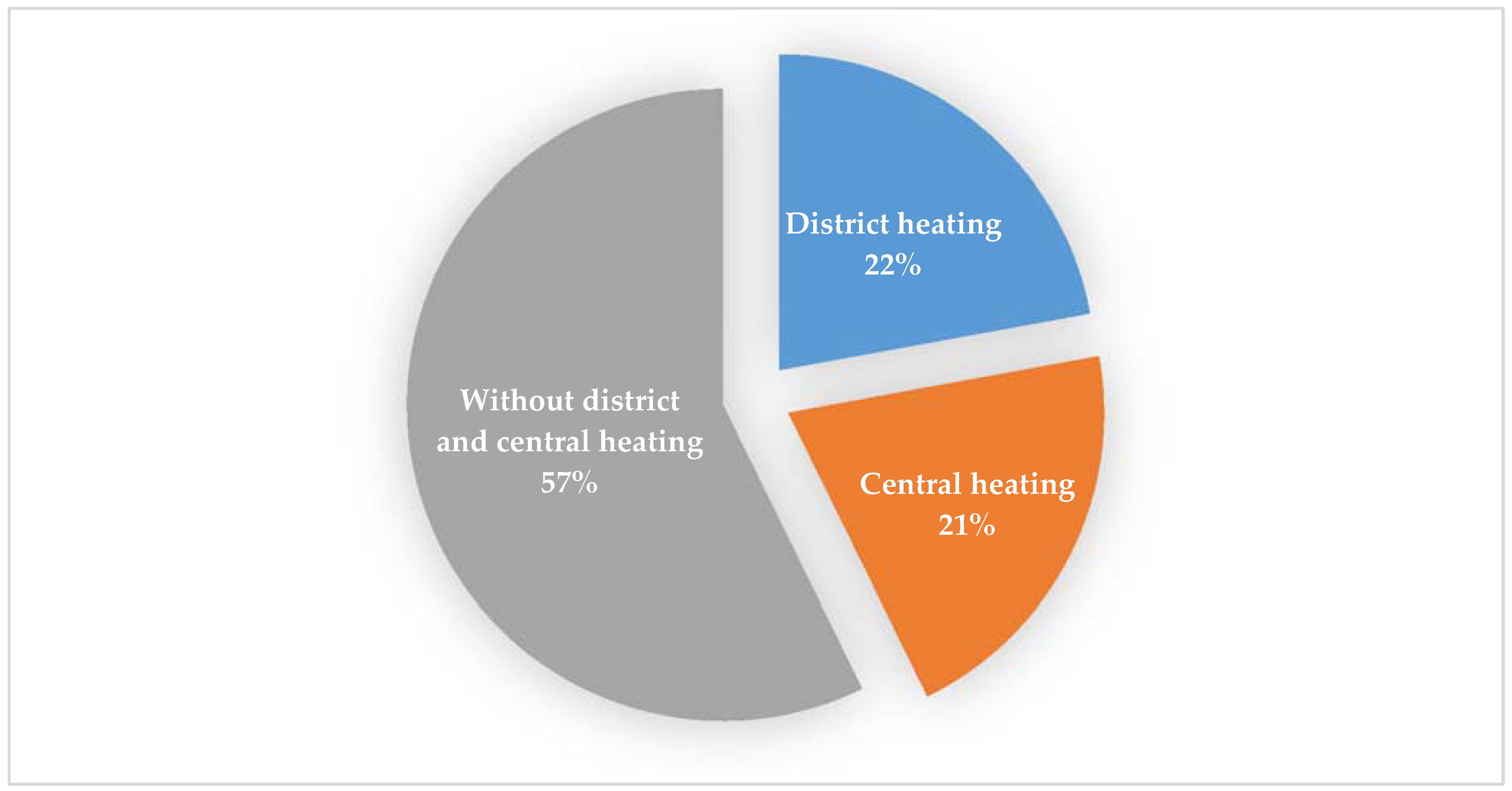
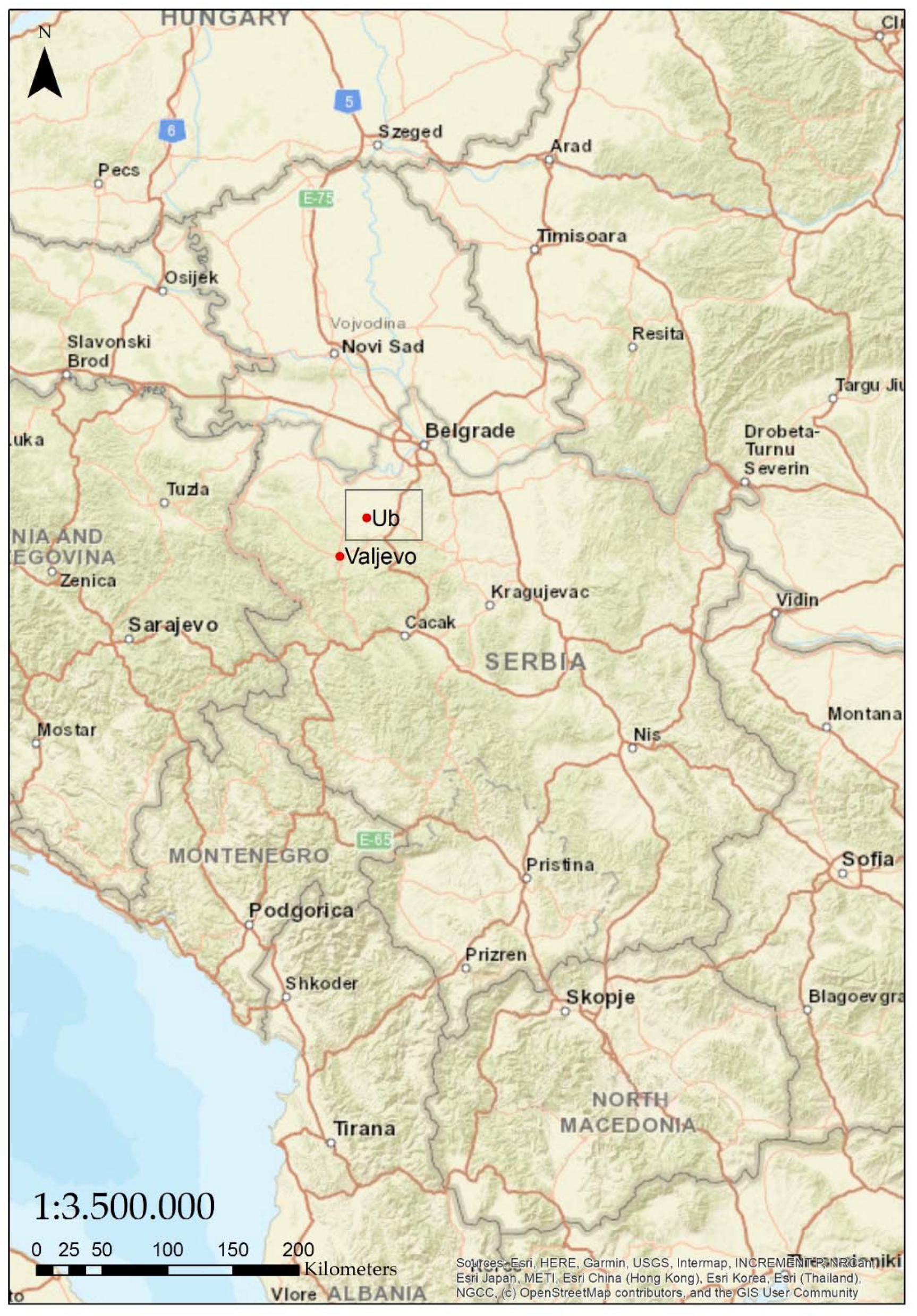
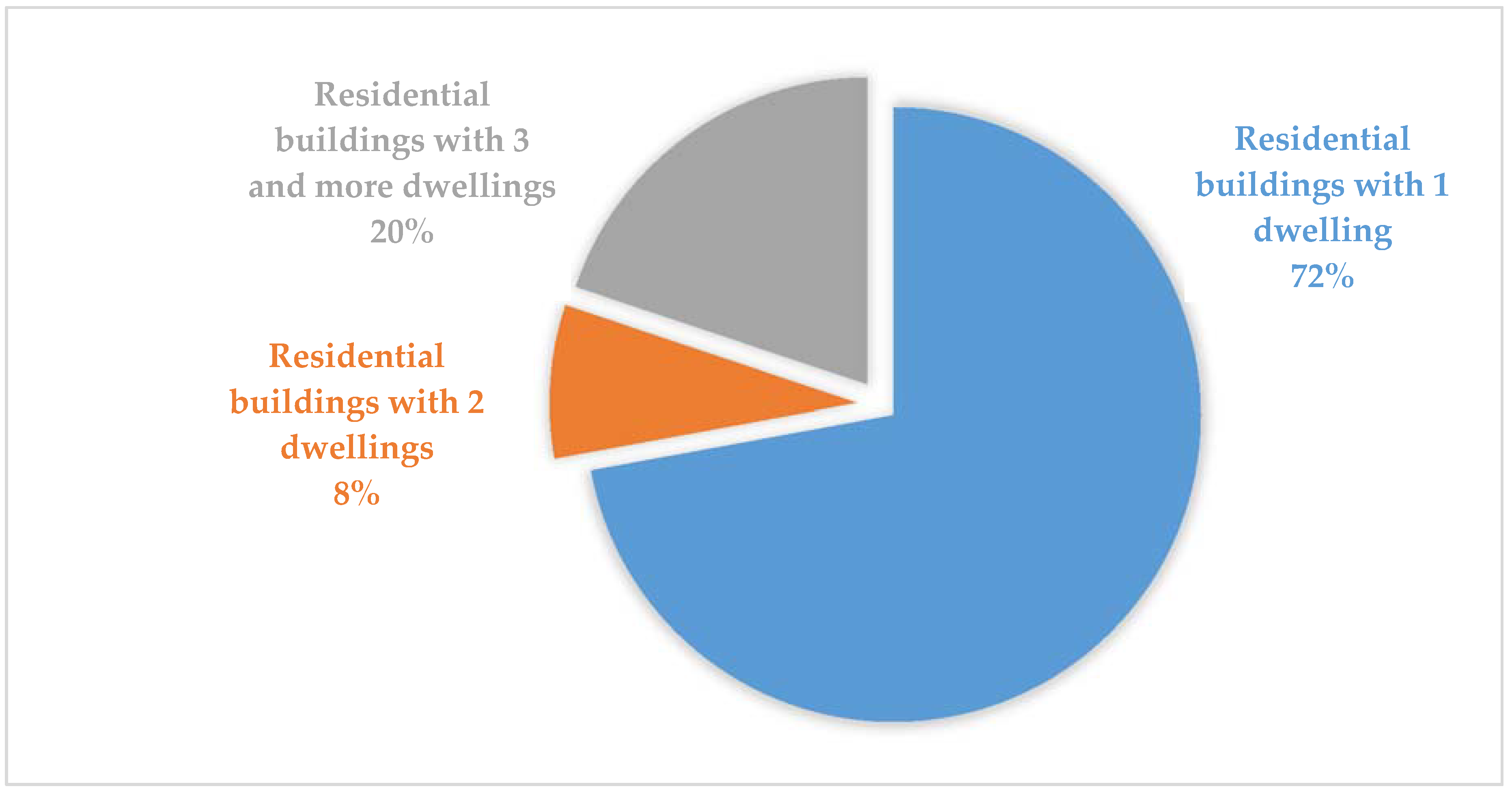
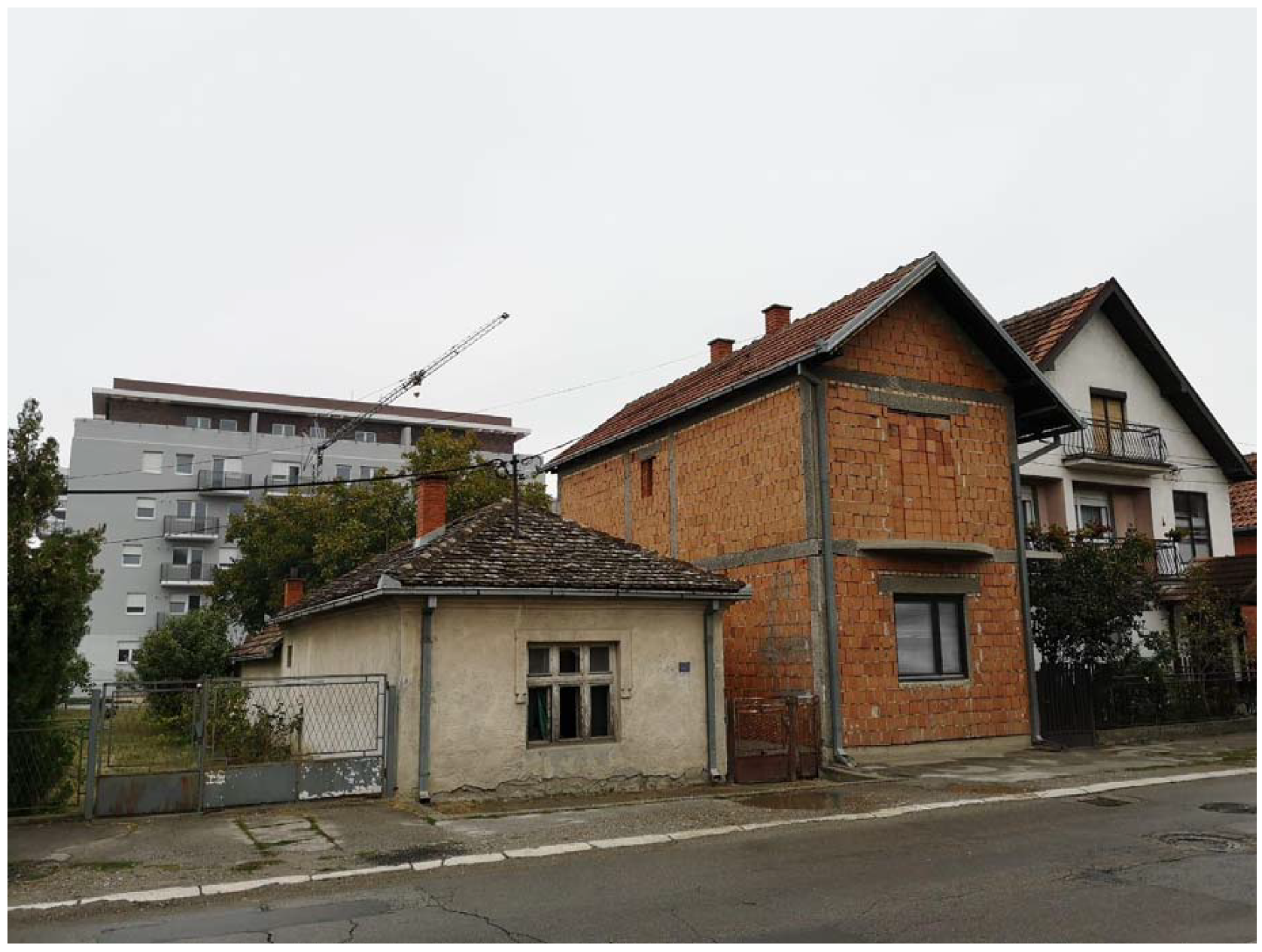
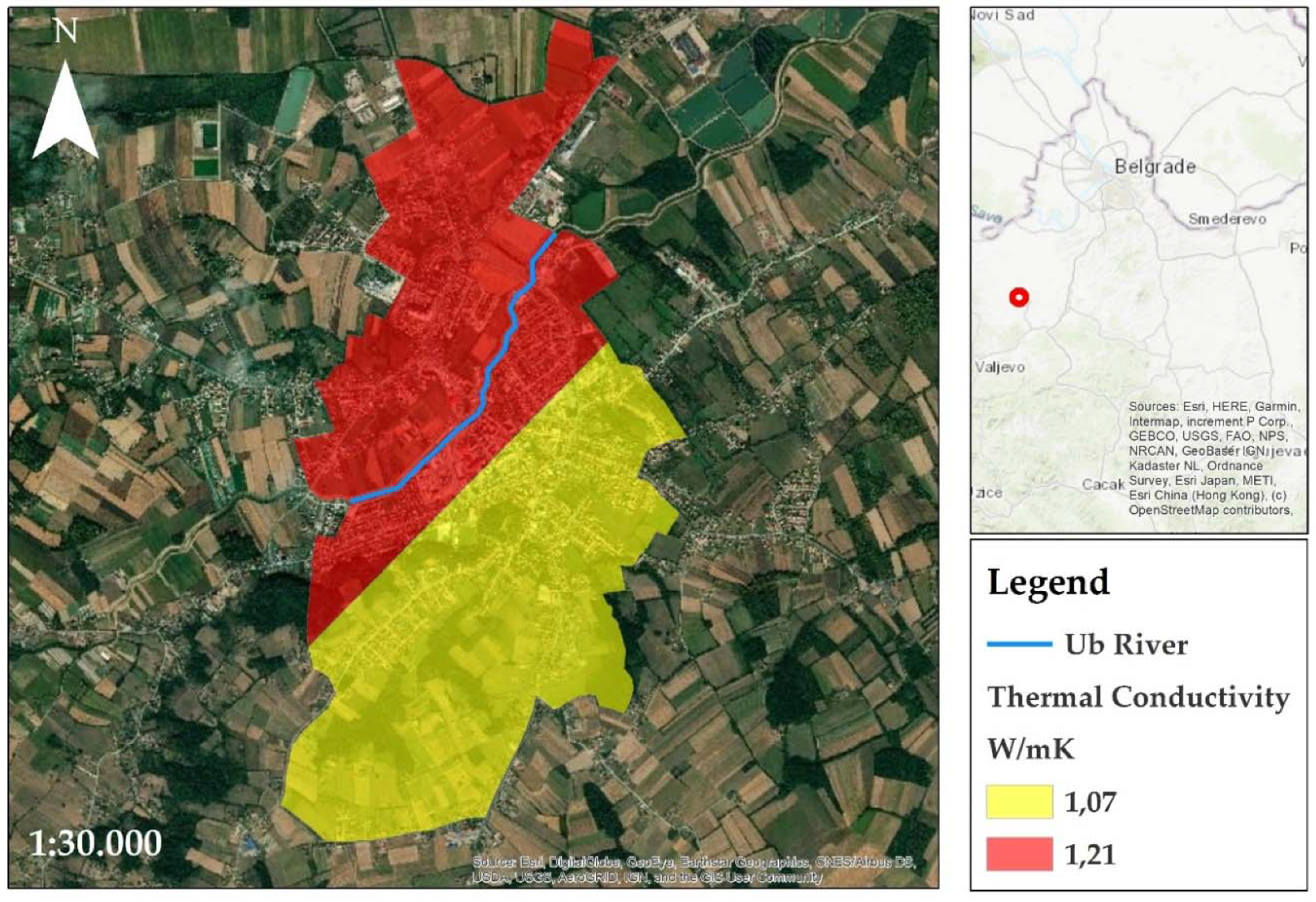
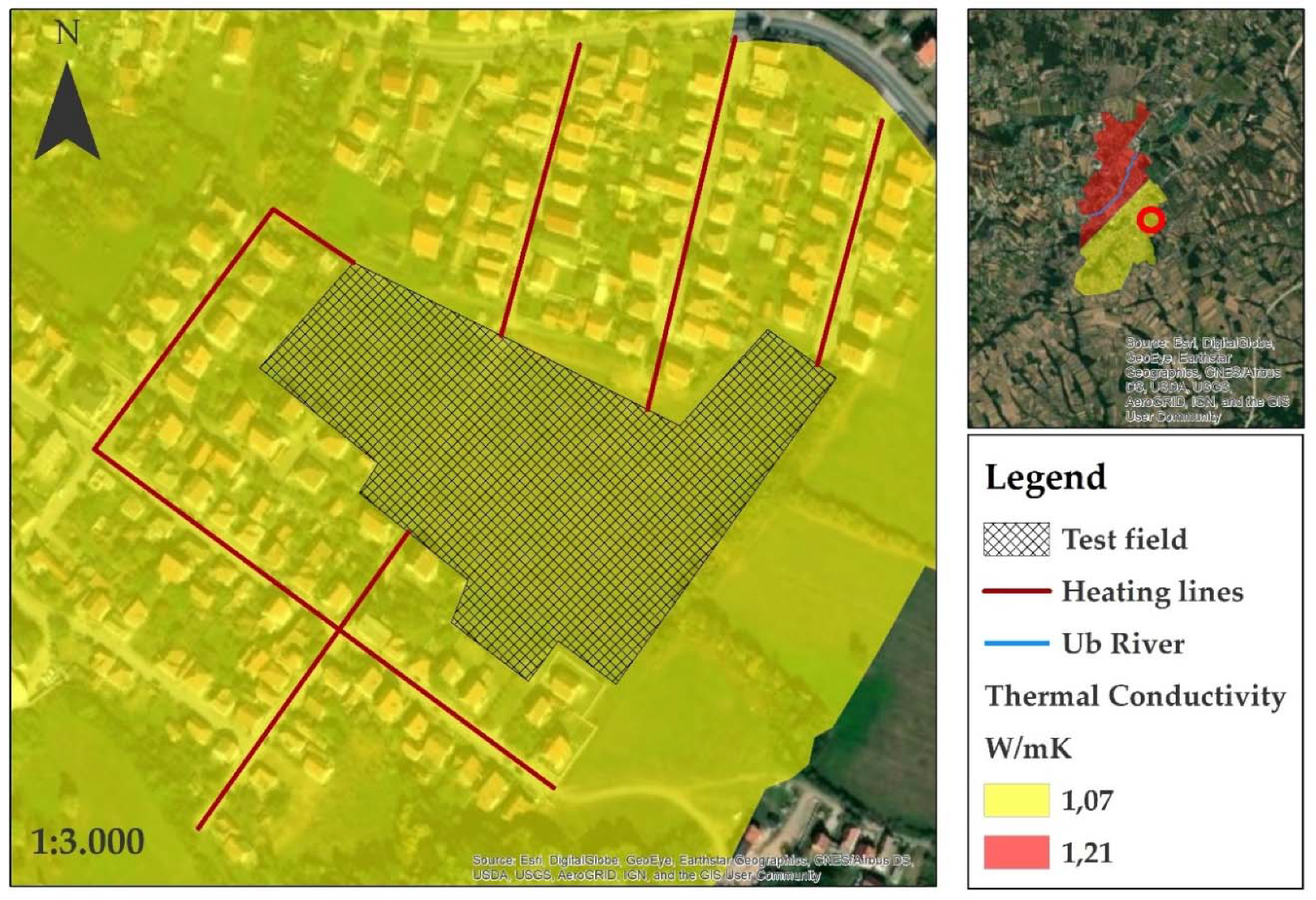
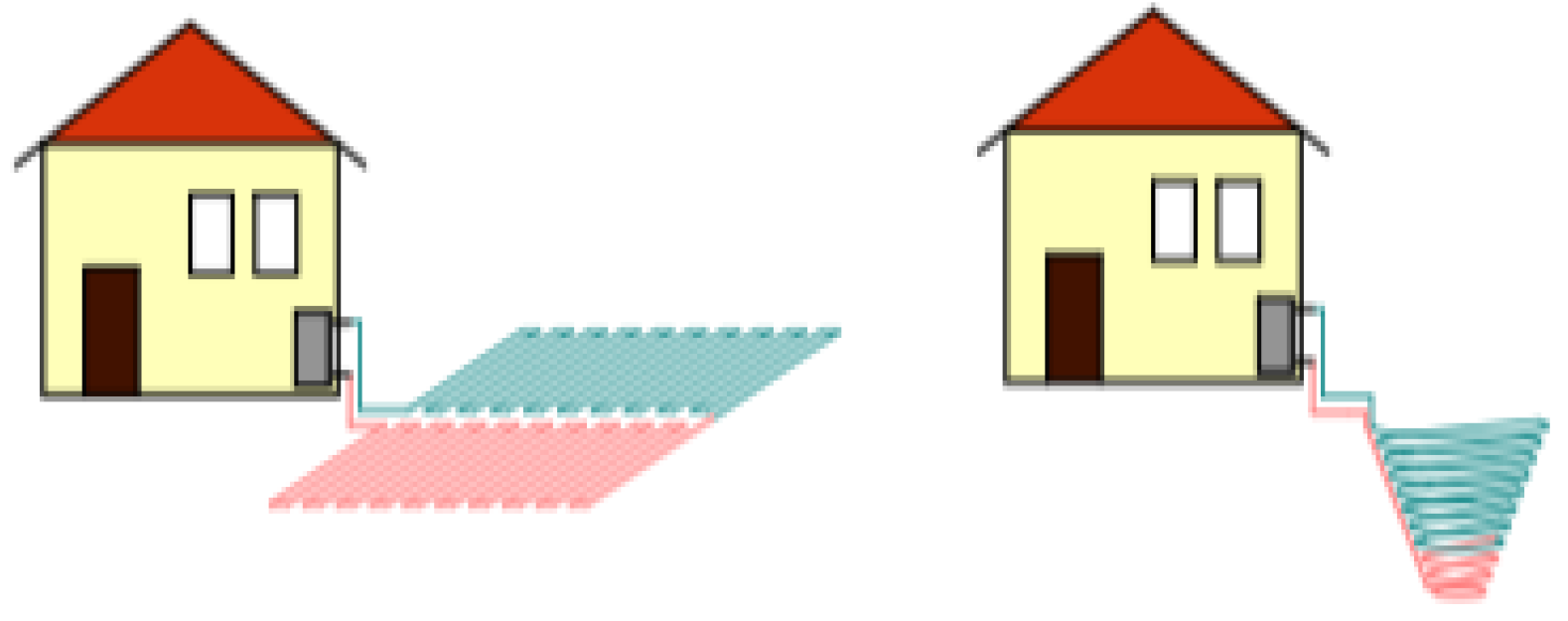
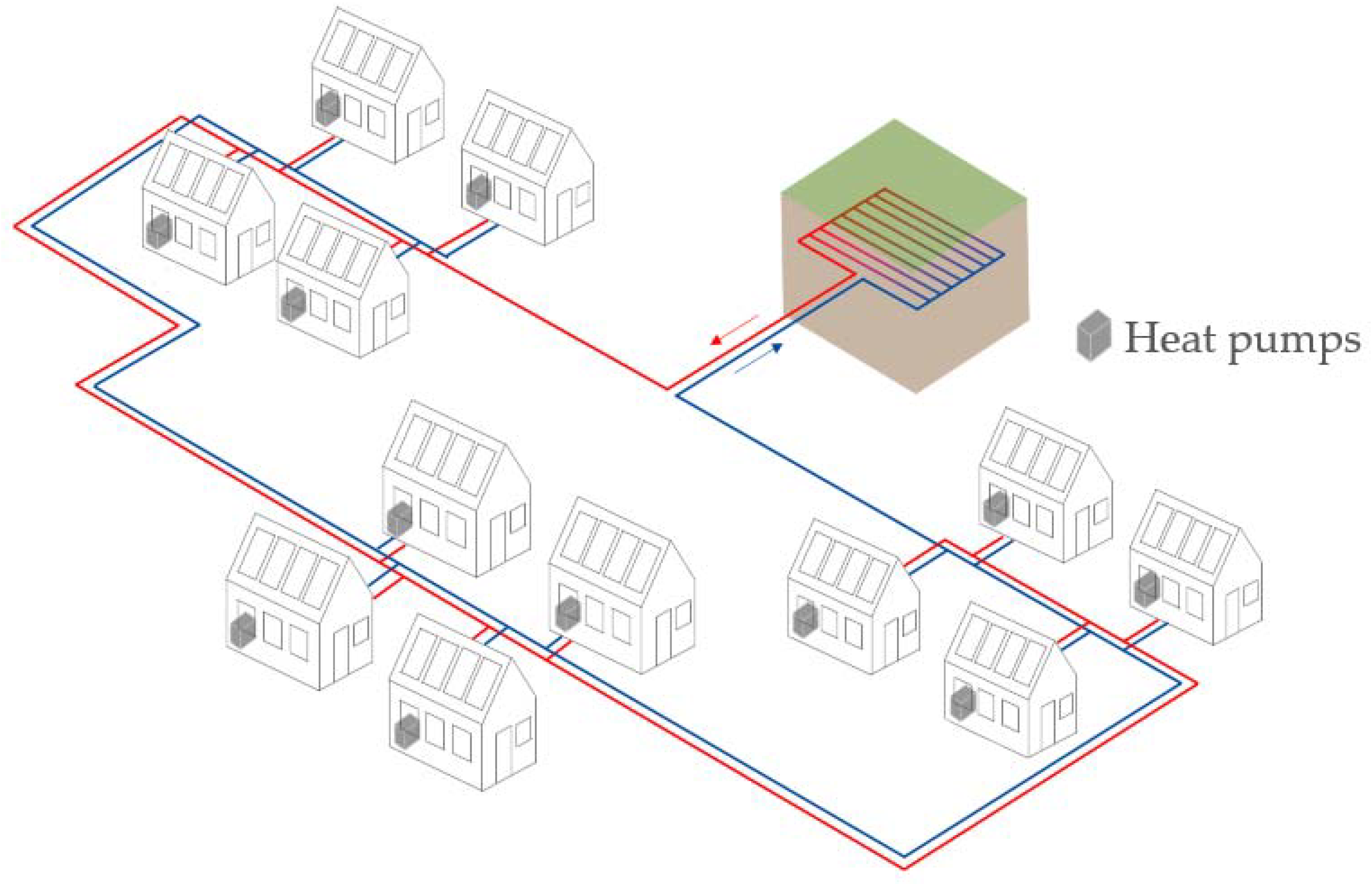
| Location | Mean Ann. Temp. | Ann. Precipitation |
|---|---|---|
| Ub (Test field) 1 | 12.08 °C | 760 mm |
| Valjevo (Meteorological station) 2 | 11.40 °C | 788 mm |
© 2020 by the authors. Licensee MDPI, Basel, Switzerland. This article is an open access article distributed under the terms and conditions of the Creative Commons Attribution (CC BY) license (http://creativecommons.org/licenses/by/4.0/).
Share and Cite
Jocić, N.; Müller, J.; Požar, T.; Bertermann, D. Renewable Energy Sources in a Post-Socialist Transitional Environment: The Influence of Social Geographic Factors on Potential Utilization of Very Shallow Geothermal Energy within Heating Systems in Small Serbian Town of Ub. Appl. Sci. 2020, 10, 2739. https://doi.org/10.3390/app10082739
Jocić N, Müller J, Požar T, Bertermann D. Renewable Energy Sources in a Post-Socialist Transitional Environment: The Influence of Social Geographic Factors on Potential Utilization of Very Shallow Geothermal Energy within Heating Systems in Small Serbian Town of Ub. Applied Sciences. 2020; 10(8):2739. https://doi.org/10.3390/app10082739
Chicago/Turabian StyleJocić, Nikola, Johannes Müller, Tea Požar, and David Bertermann. 2020. "Renewable Energy Sources in a Post-Socialist Transitional Environment: The Influence of Social Geographic Factors on Potential Utilization of Very Shallow Geothermal Energy within Heating Systems in Small Serbian Town of Ub" Applied Sciences 10, no. 8: 2739. https://doi.org/10.3390/app10082739
APA StyleJocić, N., Müller, J., Požar, T., & Bertermann, D. (2020). Renewable Energy Sources in a Post-Socialist Transitional Environment: The Influence of Social Geographic Factors on Potential Utilization of Very Shallow Geothermal Energy within Heating Systems in Small Serbian Town of Ub. Applied Sciences, 10(8), 2739. https://doi.org/10.3390/app10082739






